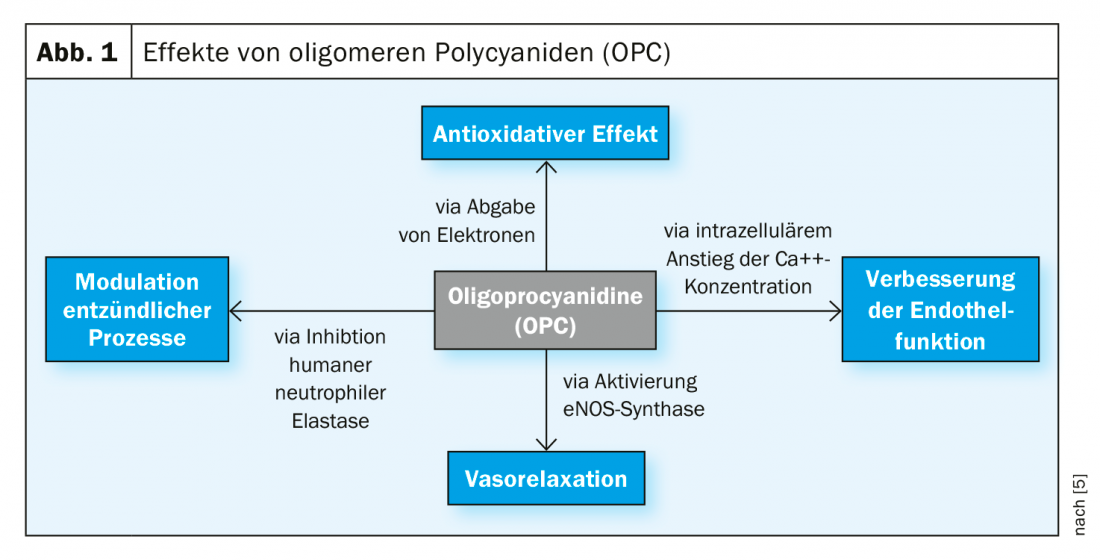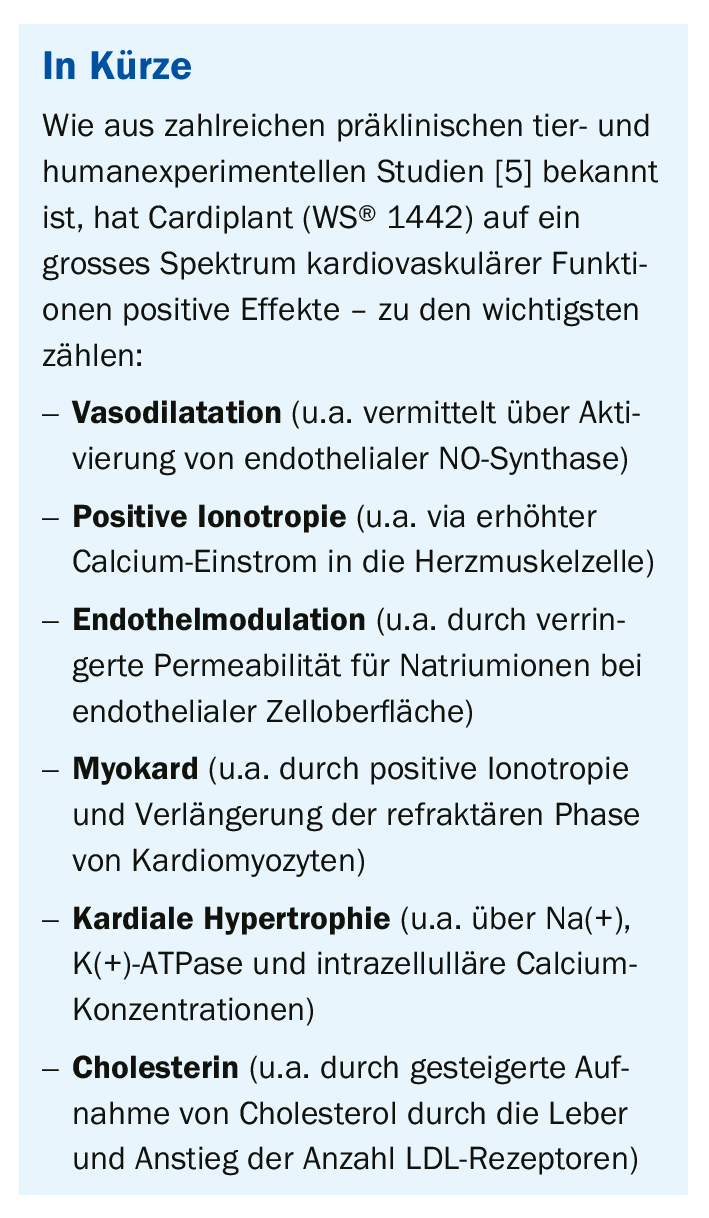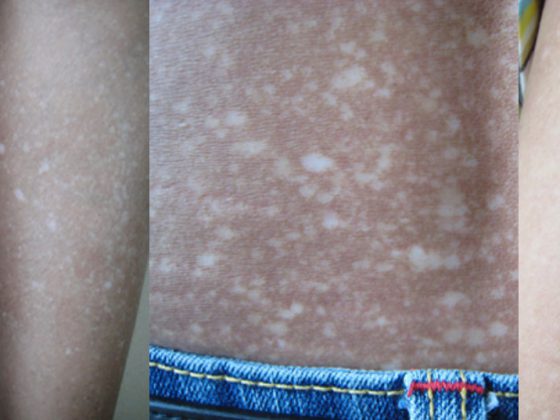The empirically proven positive effects of hawthorn extract range from vasodilation and endothelial modulation to influencing cholesterol metabolism and other cardiovascular-relevant parameters. This article highlights the underlying biochemical mechanisms of action with reference to animal and human experimental studies.
Cardiplant® 450 (active ingredient: WS® 1442) is characterized by a high degree of standardization and quantification to oligomeric procyanidins (71.6-97.0 mg OPC per tablet) [1] and is officially recommended by Swissmedic for the indication of functional cardiac complaints [2]. According to corresponding findings, this phytotherapeutic agent is also effective as an adjuvant in patients with mild to moderate heart failure [3]. The beneficial effects of hawthorn extract on the myocardium include positive ionotropy and acceleration of cardiac conduction. Due to its vasodilative properties, Crataegus also leads to an increase in blood flow to the coronary arteries. This, in turn, improves the oxygen supply to the heart and contributes to higher myocardial performance [3]. Botanically, hawthorn belongs to the genus Crataegus, which is assigned to the rose family (Rosaceae).
Oligomeric procyanidins: pharmacological key players
The pharmacologically relevant constituents of hawthorn extracts are, on the one hand, flavonoids, representatives of polyphenols, which are associated, among others, with reduced platelet activity, enzymatic modulation, anti-inflammatory effects and blood pressure lowering [4]. On the other hand, oligomeric procyanidins (OPC), also polyphenols, have a strong antioxidant effect [5], keeping blood vessels elastic and free from deposits and protecting them from future oxidative damage by free radicals. Due to their phenolic hydroxyl groups, procyanidins and flavonoids can interact with various enzymes and receptors.
The antioxidant mechanism of action of OPCs is that they act as electron donors of hydroxyl groups to help convert free radicals into inert stable radicals [5]. By reacting with other antioxidants or binding to metals, they transfer an unpaired electron. Another effect of OPCs is inhibition of human neutrophil elastase, which is released from accumulated and activated leukocytes after restoration of blood flow in previously ischemic myocardium [5]. This, in addition to modulation of endothelial function and vasodilation, is a mechanism central to the cardioprotective properties of WS® 1442 (Fig. 1) [5].

Positive effects of WS® 1442: Preclinical studies
The multiple beneficial effects of Crataegus special extract on cardiovascular functions have been demonstrated in numerous animal and human experimental studies:
- Vasodilation: Vas odilatory effects are induced via an increase in the release of nitric oxide (NO) from the vascular endothelium. From experimental studies in the isolated rat heart, it was deduced that this increase was due to activation of endothelial NO synthase (eNOS) [6,7]. That WS® 1442 also causes endothelium-dependent NO-mediated vasodilation in an isolated human artery (via eNOS phosphorylation at Serine 1177) is known from subsequent human experimental studies [8].
- Positive ionotropy: In further in-vitro studies in human myocardium a positive ionotropic effect of WS® 1442 could be demonstrated, i.e. an increase of the maximum force of the myocardium and the rate of pressure rise during the tense phase of the ventricle [9,10]. This is brought about via an increased calcium influx into the heart muscle cells.
- Endothelial modulation: In addition to playing an important role in increasing NO synthesis, WS® 1442 also plays a role in stimulating the release of endothelium-derived hyperpolarizing factor (EDHF). From numerous animal and human experimental studies, EDHF plays a role in endothelial regulation [11] and is an important factor in vascular homeostasis and angiorelaxation [12]. In animal experiments, protective effects of WS® 1442 on age-related endothelial dysfunction as well as on oxidative stress were demonstrated in rats [13]. In addition, a protective effect on the endothelial cell surface (ELS) has been postulated [5]. ELS plays an important role in endothelial homeostasis by regulating vascular permeability and inducing inactivation of pro-coagulant and pro-inflammatory processes in the subendothelium [5]. It has been shown that high sodium levels damage endothelial glycocalyx of the endothelium, which plays an important role in ELS [14]. As findings from animal experiments show, WS® 1442 has a regulatory effect by reducing permeability to sodium ions in ELS [15].
- Myocardium: In experiments on isolated rat and guinea pig cardiomyocytes, in addition to positive ionotropy (see above), a prolongation of the refractory phase was observed after Crataegus treatment, indicating an antiarrhythmic potential [16,17]. In addition, in vivo experiments in rats showed that administration of WS® 1442 for a period of 7 days resulted in a reduction in reperfusion-induced arrhythmias and mortality [18], as well as a reduction in the incidence of hypotensive crises due to left coronary artery occlusion.
- Cardiac Hypertrophy: Furthermore, Crataegus special extract WS® 1442 was observed to inhibit experimentally induced cardiac hypertrophy, a condition associated with irreversible heart failure, in animal models [19]. According to findings from animal experimental studies, the mechanism of cardiac activity of hawthorn is mediated via Na(+), K(+)-ATPase and intracellular calcium concentrations [20].
- Cholesterol: Another aspect of the cardioprotective properties of Crataegus is its effect on lowering cholesterol [5]. Thus, animal experiments showed that both total cholesterol and individual cholesterol levels (VLDL, LDL, HDL) were positively affected by stimulating the uptake of cholesterol by the liver [21]. According to recent studies, this effect can be explained by a significant decrease in acetyl-CoA [22]. A study of human cell cultures of HepG2 hepatocytes treated with WS® 1442 showed a significant increase in the number of LDL receptors as well as a decrease in apolipoprotein B100 [23]. These molecules are thought to play a key role in systemic lipid homeostasis and thus are important targets for the treatment of hyperlipidemia [5].
Source: Schwabe Pharma AG

Literature:
- Swiss Drug Compendium: Cardiplant® 450, https://compendium.ch, last accessed July 12, 2019.
- Swissmedic: Swiss Agency for Therapeutic Products. www.swissmedic.ch/swissmedic/de/home.html, last accessed 07/12/2019.
- Sudano I: Hawthorn calms, strengthens and protects the heart – Relevance for practice. PD Isabella Sudano, MD, slide presentation, VZI Highlights from Philadelphia, July 4, 2019, Zurich.
- Cory H, et al: The Role of Polyphenols in Human Health and Food Systems: A Mini-Review. Frontiers in Nutrition 2018, 5 DOI: 10.3389/fnut.2018.00087.
- Zorniak M, Szydlo B, Krzeminski TF: Crataegus special extract WS® 1442: up-to-date review of experimental and clinical experiences. J Physiol Pharmacol 2017; 68(4): 521-526.
- Miller AL: Botanical influences on cardiovascular disease. Altern Med Rev 1998; 3: 422-431.
- Koch E, Chatterjee SS: Crataegus extract WS®-1442 enhances coronary flow in the isolated rat heart by endothelial release of nitric oxide. Naunyn Schmiedeberg’s Arch Pharmacol 2000; 361 (Suppl.): R48.
- Brixius K, et al: Crataegus special extract WS® 1442 induces an endothelium-dependent, NO-mediated vasorelaxation via eNOS-phosphorylation at serine 1177. Cardiovasc Drugs Ther 2006; 20: 177-184.
- Schmidt-Schweda S, et al: The positive inotropic effect of Crataegus special extract WS® 1442 in isolated myocytes from human atrial and ventricular myocardium is predominantly mediated by oligomeric procyanidins. Z Cardiol 2000; 89(Suppl. 5): 164, Abstract No. 797.
- Schwinger RH, Pietsch M, Frank K, Brixius K: Crataegus special extract WS® 1442 increases force of contraction in human myocardium cAMP-independently. J Cardiovasc Pharmacol 2000; 35(5): 700-707.
- Feletou M, Vanhoutte PM: EDHF: new therapeutic targets? Pharmacol Res 2004; 49: 565-580.
- Kozlowska H, et al: EDHF – srodblonkowy czynnik hiperpolaryzujacy. Znaczenie w fizjologii i chorobach naczyn krwionosnych. Postepy Hig Med Dosw 2007; 61: 555-564.
- Idris-Khodja N, Auger C, Koch E, Schini-Kerth VB: Crataegus special extract WS®1442prevents agingrelated endothelial dysfunction. Phytomedicine 2012; 19: 699-706.
- Oberleithner H, et al: Salt overload damages the glycocalyx sodium barrier of vascular endothelium. Pflugers Arch 2011; 462: 519-528.
- Peters W, et al: Nanomechanics and Sodium Permeability of Endothelial Surface Layer Modulated by Hawthorn Extract WS 1442. PLoS One 2012; 7: e29972. doi: 10.1371/journal.pone.0029972
- Poepping S, et al: Effect of a hawthorn extract on contraction and energy turnover of isolated rat cardiomyocytes. Drug Research 1995; 45: 1157-1161.
- Joseph G, Zhao Y, Klaus W: Pharmacological effect profile of Crataegus extract compared with epinephrine, amrinone, milrinone, and digoxin on isolated perfused guinea pig heart. Drug Research 1995; 45: 1261-1265.
- Krzeminski T, Chatterjee SS: Ischemia and reperfusion induced arrhythmias: beneficial effects of an extract of Crataegus oxyacantha L. Pharm Pharmacol Lett 1993; 3: 45-48.
- Koch E, Sporl-Aich G: Oral treatment with the Crataegus special extract WS® 1442 inhibits cardiac hypertrophy in rats with DOCA-salt or aortic banding induced hypertension. Planta Med 2006; 72(P 265): 1061.
- Rodriguez ME, Poindexter BJ, Bick RJ, Dasgupta A: A comparison of the effects of commercially available hawthorn preparations on calcium transients of isolated cardiomyocytes. J Med Food 2008; 11: 680-686.
- Rajendran S, et al: Effect of tincture of Crataegus on the LDLreceptor activity of hepatic plasma membrane of rats fed an atherogenic diet. Atherosclerosis 1996; 123: 235-241.
- Zhang Z, Ho WKK, Huang Y, Chen ZY: Hypocholesterolemic activity of hawthorn fruit is mediated by regulation of cholesterol-7a-hydroxylase and acyl CoA: cholesterol acetyltransferase. Food Res Int 2002; 35: 885.
- Koch E, Lanzendorfer-Goossens H, Weibezahn C: Crataegus extract WS® 1442 inhibits apolipoprotein B100 (ApoB) secretion and increases low-density lipoprotein receptor (LDL-R) transcription in human HepG2 cells. Z Phytother 2006; 27: 25-26.
FAMILY PRACTICE 2019; 14(9): 36-37












